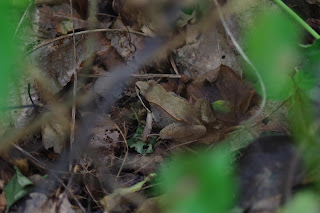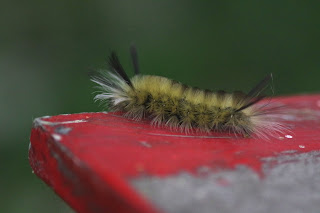I think this is the same Virginia ctenucha moth that was on the plant yesterday. It was there the whole time I stood observing this garden, and for most of my bug walk (which I know because I walked by there several times), which lasted around 2 hours. At the end, it was gone (but I think I know where it went–more on that later).
Lots of honeybees
Assassin bug nymph. I am surprised that there weren't more predators to be found, with so much potential prey.
The bumblebees enjoy the autumn joy sedum and the goldenrod
Wasp
Did I mention that bumblebees love autumn joy sedum? ('Cause it's a heart? See?)
There were many orders of insects represented in the garden patch: above you have seen Hymenoptera, Lepidoptera, Hemiptera... now for Diptera:
Crane fly on the grass right next to the garden patch
Sweat bee on wood sorrel
Weevil–add Coleoptera to the list of insect orders represented.
Wasp
Hover fly
I can't tell if this tiny thing is a tiny wasp or a tiny fly
Long-legged fly
Wasp
Sweat bee
Wasp
Another crane fly, among the greenery in the garden
Ant. There are ants here and there on the flowers.
Several katydids were hopping about.
All of that life in just a small patch of my backyard. And there were others that I saw, but did not get a chance to photograph (or even identify). And who knows what's in there that I just didn't see? Many things could be hiding among the greenery. Also, this is the area where I found the stick bug the other day, and in recent weeks this has been the place where I have seen butterflies and moths quite a bit. Just a tangled bit of garden, and so many insects that benefit from it.
Backyard Bug of the Day:
Ailanthus webworm moth. I have been wondering when these would finally make an appearance. The two places I most commonly see these are my front porch at night, attracted to the light, and on goldenrod. Here it is on a goldenrod leaf.
Backyard Co-Amphibian of the Day #1:
Backyard Co-Amphibian of the Day #2:
It's rare for me to see two frogs in a day; it's even rarer to see three, and yet, here's the third frog I saw today.
Other Bugs:
There is temporarily a red, metal pedestal in my backyard that is curiously popular with banded tussock moth caterpillars. I don't know why, but lately I very frequently find them resting under the top edge. Today I found this one crawling along the top...
... and as I watched it, it fell off the edge and landed on this leaf, where there was a fall webworm...
... and then about an hour or so later I went by, and there it was on the top again!
I planted this in the rock garden last fall (I can't remember what it's called), and it's been blooming for about a week now, and today was the first time that I saw any insects pollinating the flowers. About time!
Small flowers, small bees.
Tiny wasp
The grasshoppers (and crickets) were back in great numbers, and very flitty, in the rock garden today. These two were interesting to observe:
First, they both jumped onto the rock...
... Then one jumped onto the other. It quickly fell off, and then crawled back onto the rock...
... where the two of them eyed each other for a while, waggling their legs. I think the larger one–the one that jumped on top of the other–is a female. Ultimately nothing came of this, and they both hopped/flew away.
Cricket
Still there. I have decided that though I will continue to check on this, I won't post about it after today unless something dramatic happens. Or something undramatic happens. Whichever.
Leaf hopper on galls
Sharpshooter
Today I could see two contracted datanas. They had moved a little higher in the tree.
Thread-waisted wasp
Lady beetle. I haven't seen very many of these this year.
Leaf hopper. It looks like it has been the survivor of an attack.
Pop quiz: How do we find tree crickets?
Notice the antennae peeking out from leaves? Correct!
Some kind of geometer moth, I think.
Virginia ctenucha moth on goldenrod. It could be the same one from the autumn joy sedum. Or not. Impossible to tell.
There are a couple of purple cone flowers that have been very popular with these leaf hopper nymphs lately.
Jagged ambush bug. I haven't seen many ambush bugs this year, either.
It is sitting on top of a purple cone flower, waiting for an insect to come close enough to grab. When I put my hand on the stem of the plant to turn it so I could take this shot, a whole bunch of those leaf hopper nymphs hopped out. There were lots of bugs on this plant, but none within reach of the ambush bug.
Weevil?
Caterpillar
The ant was joined by other ants in tending its flock of aphids today.
Katydid. I spotted this out the window after I finished my bug walk, and went back out to get pictures of it. Here it is on a piece of old siding that has been removed from the house, and is sitting outside still. I tried to coax the katydid off of it onto the rock it is leaning on, and it flew away. It is still a strange and novel thing to see a katydid fly.
Here's where it landed.
Tiny moth. For scale, that is deer netting.
I am concerned about the monarch chrysalis:
It has these two dark lines. I have never seen that on a chrysalis before. Also, in the evening I saw a wasp flying around inside the enclosure. Now, the enclosure has been open since the caterpillar went into its J, because it's not going to wander off at that point, and I have seen a few of those wasps in the house in the last few weeks. So I am hopeful that it just happened to fly in there, and that nothing has happened to the chrysalis. Time will tell...
Something else time will tell:
You can't tell the sex of a monarch caterpillar by looking at it, but apparently you can tell from the chrysalis.
That tiny crease there indicates this will be a female butterfly... if it emerges.
.
.
.
.
.
.
.
.
.
.
.
.
Nursery web spider
There are some wasps that parasitize spiders; they sting them to paralyze them, and then stuff them into a burrow with its larva, still alive, for the larva to be able to feed on fresh "meat." Here is a wasp subduing a spider.
This harvestman (which is missing several legs) was also in the garden with all of the bugs above. Notice it has a mite attached to it.







































































No comments:
Post a Comment